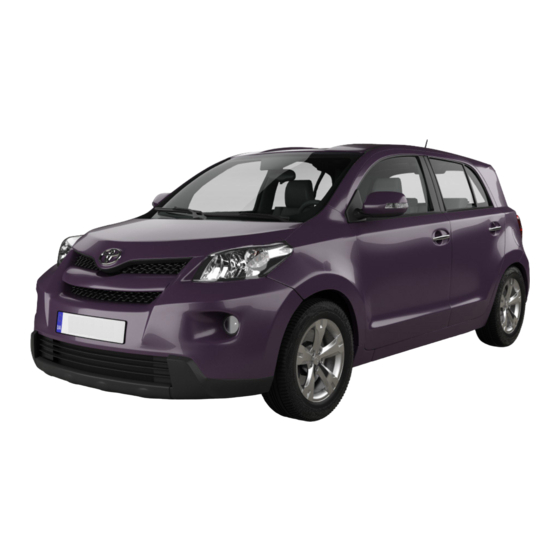Table of Contents
Advertisement
Advertisement
Table of Contents

Summary of Contents for Toyota Urban Cruiser
- Page 1 Urban Cruiser Brief Guide...
-
Page 3: Table Of Contents
Eco-Driving Introducing Urban Cruiser Thank you for buying an Urban Cruiser. We trust this Brief Guide will enable you to become familiar with your vehicle’s basic operations and assist you in enjoying your vehicle. This brief guide does not replace or substitute the Owner’s Manual, which you will find in the vehicle’s glove compartment. -
Page 4: Accessing Your Vehicle
Accessing your vehicle Vehicles without smart entry & start Vehicles with smart entry & start system system 1. Electronic keys. - Operate smart entry & start system. 1. Master keys (with wireless remote control - Operate the wireless remote control function. function). -
Page 5: Child Rear Door Protection Lock
Accessing your vehicle Unlocking and locking the doors (front door handles only) Grip the handle to unlock. Press the button to lock. Make sure to touch the sensor on the back of the handle. The doors cannot be unlocked for 3 seconds after they are locked. Child rear door protection lock The door cannot be opened from inside the vehicle when the locks are set. -
Page 6: Seat And Seat Belt Adjustment
Seat and seat belt adjustment Front seats 1. Seatback angle adjustment lever. 2. Seat position adjustment lever. 3. Vertical height adjustment lever (driver’s side). Head restraint height adjustment The centre of the head restraint should be level with the top of the ears Lock release 1. -
Page 7: Steering Wheel Adjustment
Seat and seat belt adjustment Rear centre seat belts Make sure that the buckle (1) is securely latched for ready use of the centre seat belt. 1. Insert the tab with the hooked end. 2. Insert the tab with the concave end. Steering wheel adjustment Hold the steering wheel and press the lever down. -
Page 8: Instrument Panel Overview
Instrument Panel Overview Gauges and meters Windscreen wipers and Multi-information display washer switch. Rear window wiper and washer switch Headlight switch Turn signal lever Fog light switch Audio system Navigation system* Heating and A/C control SRS knee airbag Tilt and telescopic steering lock release lever Bottle holder Fuel filler door opener A. -
Page 9: Steering Wheel Controls
Steering wheel instruments Area A indicated on instrument panel overview (page 6). Audio remote control switches Telephone switch* Talk switch* Engine (ignition) switch (vehicles Engine (ignition) switch (vehicles with smart entry & start system) without smart entry & start system) * On some models... -
Page 10: Instrument Cluster
Instrument cluster Vehicles without smart entry and start system The following gauges, meters and displays illuminate when the engine switch is in the ‘‘ON’’ position. Vehicles with smart entry & start system The following gauges, meters and displays illuminate when the ‘‘ENGINE START STOP’’ switch is in the IGNITION ON mode. -
Page 11: Lights
They will turn off after the engine is started. There may be a malfunction if a light does not come on, or if the lights do not turn off. Have the vehicle inspected by your Toyota dealer. *: For details, please see your Owner's manual, Chapter 2-2. -
Page 12: Wipers
Wipers 1. Intermittent wiper operation. 2. Low speed wiper operation. 3. High speed wiper operation. 4. Temporary operation. Rear window wiper and washer 1. Intermittent window wiper operation. 2. Normal window wiper operation. 3. Washer/wiper dual operation. 4. Washer/wiper dual operation. When the rear window is dry do not use the wipers, as they may damage the rear window. -
Page 13: Starting Your Vehicle
Starting your vehicle For vehicles without smart entry key positions are as follows: 1. Lock:- The steering wheel is locked and the key can be removed. 2. ACC:- Some electrical equipment such as audio can be used. 3. On:- All electrical equipment can be used. 4. -
Page 14: Heating, A/C And De-Misting
Heating, A/C and de-misting Manual air conditioning system Fan speed control dial Air outlet selection Temperature dial control dial Air conditioning ON/OFF Air intake selection dial switch (if equipped Automatic air conditioning system Airflow of outlets are automatically adjusted according to the temperature setting. Temperature setting display Automatic mode Windscreen defogger... -
Page 15: Setting The Clock
Setting the clock When the battery is disconnected 1. Adjusts the hour. 2. Adjusts the minutes. The time display will automatically be set to 1:00. 3. Rounds to the nearest hour* * eg. 1:00 to 1:29 = 1:00 1:30 to 1:59 = 2:00... -
Page 16: Gear Change
Gear change Manual transmission The shift pattern is as shown. Gear lever for ‘‘R’’ (Reverse) Lift up the ring and shift lever to the ‘‘R’’ position. Shift pattern Fully depress the clutch pedal before operating the gear lever, and then release it slowly, once a gear is selected. -
Page 17: Fuel Tank Opening
Fuel tank opening Before refueling the vehicle Opening the fuel tank cap Vehicles without smart entry & start system Press the fuel filler door opener switch. Turn the fuel tank cap slowly to open. Turn the engine switch to the “LOCK” position and ensure that all the doors and windows are closed. -
Page 18: Eco-Driving
Eco-Driving What is ‘‘Eco-Driving’’?’ • Eco-Driving = Driving in a more careful and environmentally responsible way • Eco-Driving = Reduced fuel costs • Eco-Driving = Reduced Environmental impact Saving of CO emissions. Eco-Driving Savings Total potential saving of 20 - 30%. Open windows increase fuel Roof load...








